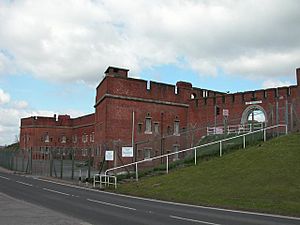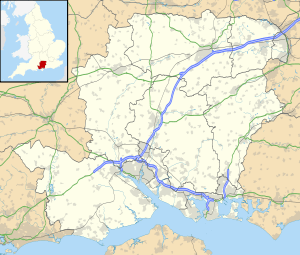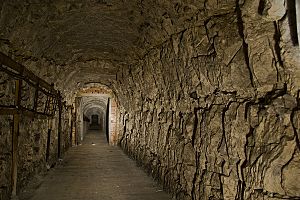Fort Southwick facts for kids
Fort Southwick is one of the many forts found on Portsdown Hill. This hill overlooks the important naval base of Portsmouth in Hampshire, England. The fort was built to protect the naval base from attacks coming from the land.
Contents
History of Fort Southwick
Fort Southwick was built after a special group, the Royal Commission on the Defence of the United Kingdom, suggested it in 1860. They wanted to make sure Portsmouth's naval base was safe.
Building the Fort
Construction of Fort Southwick began in 1861 and finished by 1870. It is the highest fort on Portsdown Hill. It also held the water tanks that supplied water to the other forts nearby. Water was sent through a brick-lined aqueduct, which is like a special channel for water.
The fort was designed to hold about 220 soldiers. They lived in a crescent-shaped building called a barrack block. The fort had strong defenses, including a full caponier and two smaller demi-caponiers. These were special structures that allowed soldiers to fire along the dry ditch around the fort, keeping attackers out. A small gallery for muskets (old-fashioned guns) also crossed the ditch. There were also mortar batteries, which are places for firing mortars (weapons that shoot bombs high into the air).
Guns and Defenses
By 1893, Fort Southwick was armed with 23 guns. These included:
- Nine 64 Pounder Rifled Muzzle Loading Guns. These were large guns where the ammunition was loaded from the front.
- Eight 7-inch Rifled Breech Loading (RBL) guns. These guns were loaded from the back, which was a newer design.
- Six 8-inch (20 cm) rifled muzzle loaded howitzers. Howitzers are like cannons but can shoot shells at a higher angle. Some were on the ground, and others could be moved.
Inside the fort, a spiral staircase led down to four main tunnels. These tunnels spread out from the center and led to the barrack block, the caponiers, and the magazine (where ammunition was stored).
Fort Southwick in World War II
During the Second World War, Fort Southwick became a very important secret place. A special underground headquarters, called UGHQ, was built 100 feet (30 meters) below the fort. This was done between February and December 1942. It was so deep that no bombs from that time could reach it.
This underground base was the main communication center for Operation Overlord. This was the code name for the D-Day landings in Normandy, France, in 1944. The secret call sign for this base was 'MIN'.
Later Uses of the Fort
The guns were removed from Fort Southwick in 1906. However, the military still used the fort. It served as a barracks (a place for soldiers to live). It was also used to train soldiers on how to attack and defend a fort.
After the First World War, the fort became a demobilisation center for three years. This meant soldiers who had finished fighting came here to be officially released from the army.
Fort Southwick was part of the Admiralty Research Establishment until 2002. This was a place where the navy did research. After 2002, the fort was no longer used by the military. In 2003, the Ministry of Defence sold it. The new owners, "Fort Southwick Company Limited," plan to turn the old barrack block into fancy apartments.
Since 1987, Fort Southwick has been a Grade I Listed Building. This means it is a very important historical building and is protected.




